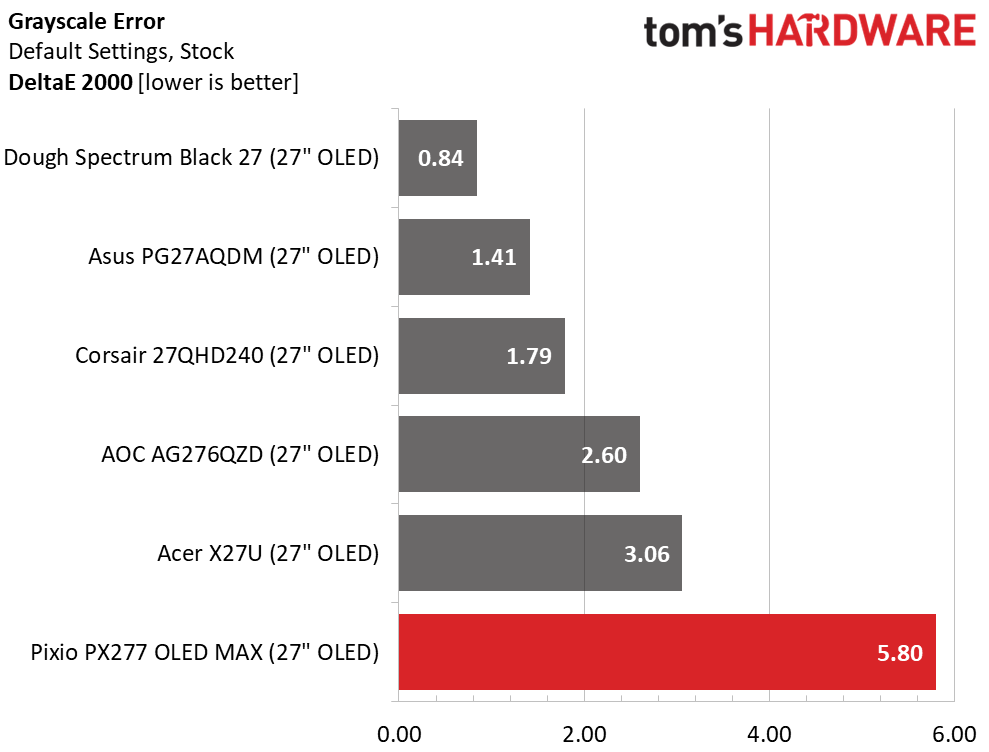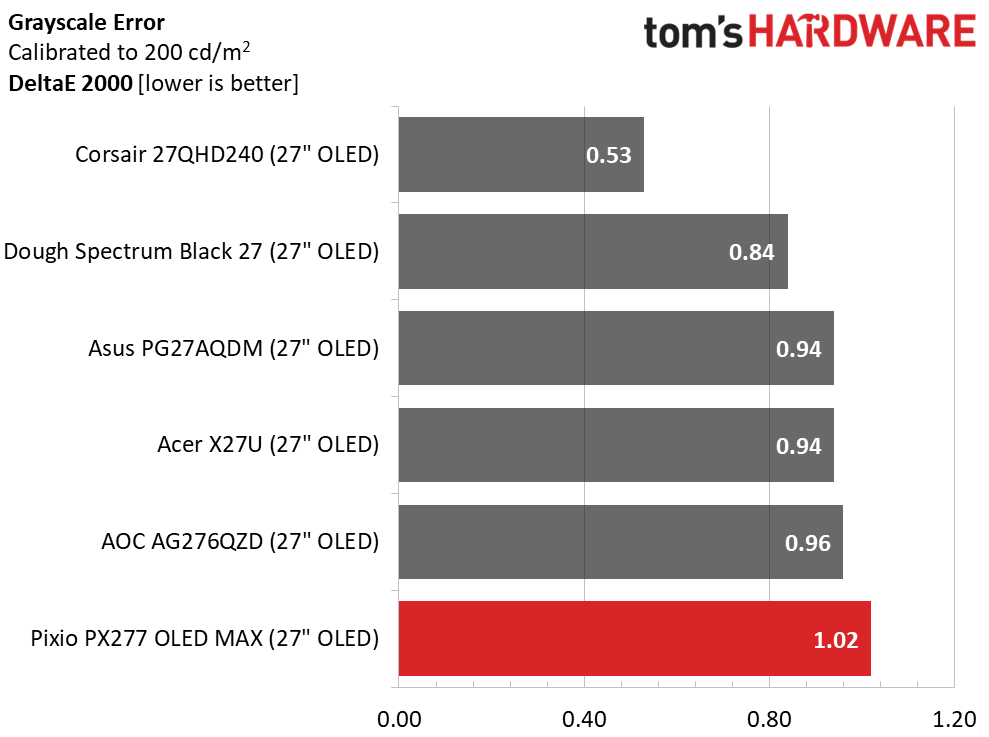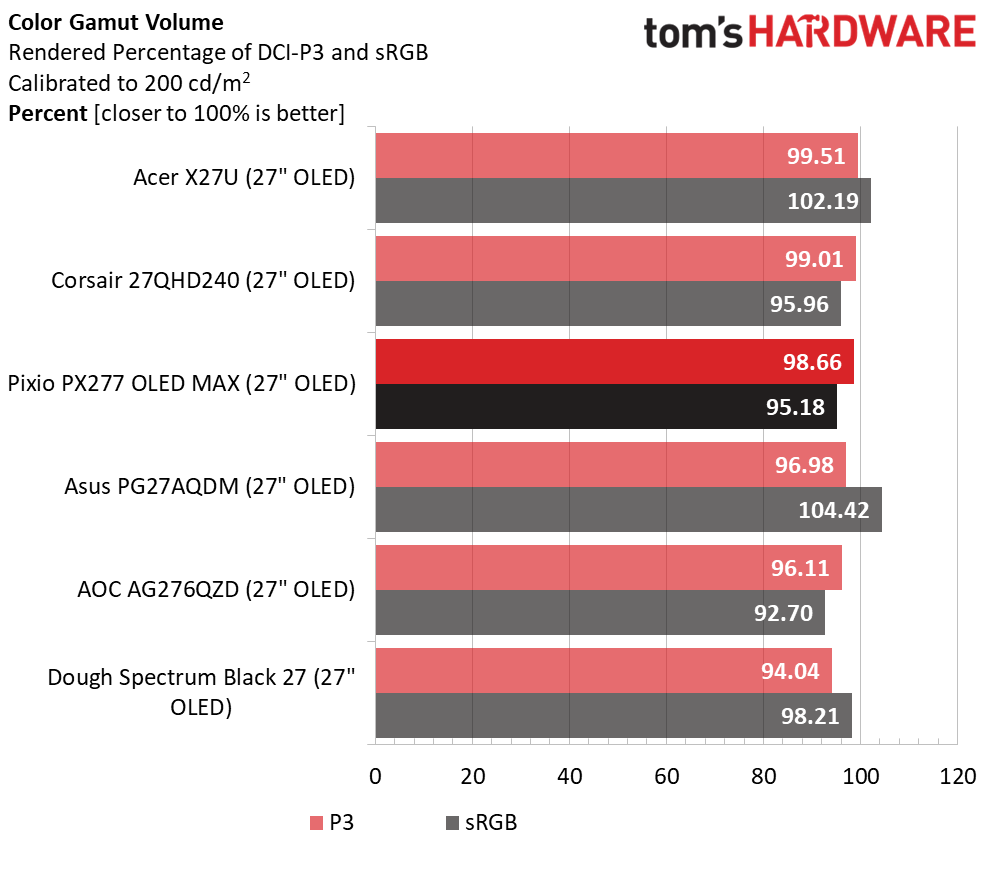Why you can trust Tom's Hardware
Most OLEDs I’ve reviewed don’t need calibration but the PX277 OLED MAX benefits from a few tweaks. It’s a small sacrifice to make to save $100. Once adjusted, it has the same color accuracy as its competition.
Grayscale and Gamma Tracking
Our grayscale and gamma tests use Calman calibration software from Portrait Displays. We describe our grayscale and gamma tests in detail here.



The PX277 OLED MAX’s default grayscale run is clearly too blue in tone. You can see the errors from 20-100% brightness, so something should be done. Gamma runs a bit light but tracks straight, which is a good thing.
Calibration neatly takes care of the grayscale errors. Now, none are visible. Gamma is a compromise, though. Changing the option from 2.2 to 2.4 is a visual improvement, but it would be better if it rode the 2.2 line more closely. Values are still tight enough for goodness, but the picture is slightly dark. You can compensate with the brightness control to get a more vivid look if you wish.
When the sRGB color gamut is selected, gamma and color temp controls are grayed out. You can still adjust brightness, though. Gamma is very light at the dark end of the scale which means shadow areas are more gray than black. There aren’t any visible grayscale errors though, which is a good thing. If gamma were tighter, this would be a pro-level picture mode. But as it stands, I can only recommend it for gaming.
Comparisons




The PX277 OLED MAX lags a bit behind the average in the out-of-box grayscale comparison. 5.80dE is the highest value I’ve recorded for an OLED in this test. But fear not; a few changes to the RGB sliders restores the faith. A 1.02dE grayscale error is more than acceptable for a $100 price savings.
Gamma is just fair, with a 0.18 range of values and a 4.54% deviation from 2.2. The actual value is 2.3. One can choose to leave gamma alone, and it will track around 2.1. The PX277 OLED MAX looks better with the darker 2.4 option because it increases color saturation, as shown below.
Get Tom's Hardware's best news and in-depth reviews, straight to your inbox.
Color Gamut Accuracy
Our color gamut and volume testing use Portrait Displays’ Calman software. For details on our color gamut testing and volume calculations, click here.



The PX277 OLED MAX’s gamut charts show the effects of inaccurate grayscale tracking. Though saturation points are linear, the secondary colors, cyan, yellow, and magenta, are visibly off in hue. The light gamma also desaturates color across the board, contributing to a flat picture with less life than an OLED panel is capable of.
The picture improves significantly with grayscale calibration, gamma change, and a reduction of the contrast slider. There is nothing to complain about here; it just takes some work to get there.
sRGB is undersaturated in red and off-hue in magenta but otherwise on point. With a 1.69dE error, it is accurate, but its light low-end gamma makes it questionable for color-critical applications. It’s fine for gaming, though.
Comparisons


When comparing DCI-P3 color, the PX277 OLED MAX is right in the mix with the other monitors. 1.23dE is well below the visible threshold. Its sRGB score of 1.69dE is also competitive.
The PX277 OLED MAX’s color volume brooks no complaint. It covers almost 99% of DCI-P3, which puts it above average for wide gamut screens. You can’t get much more without adding that Quantum Dot layer. Currently, you’ll find that more often in larger screens. It isn’t common in the 27-inch segment. The 95.18% score for sRGB is due to the under-saturated red primary.
Test Takeaway: The PX277 OLED MAX is capable of excellent color accuracy but needs more attention than other OLEDs. But for a $100 savings, it isn’t too great a sacrifice. It has almost 100% coverage of DCI-P3 color, which is impressive for a non-QD monitor. I just wish the gamma tracked closer to 2.2 and for a better sRGB mode.
MORE: Best Gaming Monitors
MORE: How We Test PC Monitors
MORE: How to Buy a PC Monitor
MORE: How to Choose the Best HDR Monitor
Current page: Grayscale, Gamma and Color
Prev Page Brightness and Contrast Next Page HDR Performance
Christian Eberle is a Contributing Editor for Tom's Hardware US. He's a veteran reviewer of A/V equipment, specializing in monitors. Christian began his obsession with tech when he built his first PC in 1991, a 286 running DOS 3.0 at a blazing 12MHz. In 2006, he undertook training from the Imaging Science Foundation in video calibration and testing and thus started a passion for precise imaging that persists to this day. He is also a professional musician with a degree from the New England Conservatory as a classical bassoonist which he used to good effect as a performer with the West Point Army Band from 1987 to 2013. He enjoys watching movies and listening to high-end audio in his custom-built home theater and can be seen riding trails near his home on a race-ready ICE VTX recumbent trike. Christian enjoys the endless summer in Florida where he lives with his wife and Chihuahua and plays with orchestras around the state.
